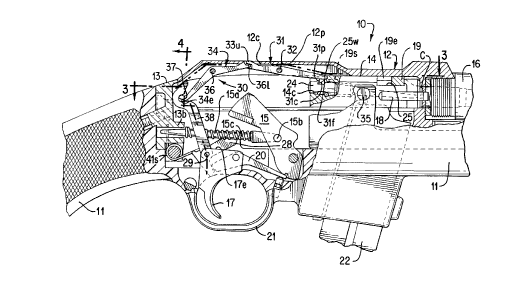Une partie des informations de ce site Web a été fournie par des sources externes. Le gouvernement du Canada n'assume aucune responsabilité concernant la précision, l'actualité ou la fiabilité des informations fournies par les sources externes. Les utilisateurs qui désirent employer cette information devraient consulter directement la source des informations. Le contenu fourni par les sources externes n'est pas assujetti aux exigences sur les langues officielles, la protection des renseignements personnels et l'accessibilité.
L'apparition de différences dans le texte et l'image des Revendications et de l'Abrégé dépend du moment auquel le document est publié. Les textes des Revendications et de l'Abrégé sont affichés :
| (12) Brevet: | (11) CA 2250503 |
|---|---|
| (54) Titre français: | SYSTEME DE VERROUILLAGE DE PERCUTEUR ET DE CULASSE D'ARME A FEU |
| (54) Titre anglais: | FIREARM'S BOLT FIRING PIN LOCKING SYSTEM |
| Statut: | Réputé périmé |
| (51) Classification internationale des brevets (CIB): |
|
|---|---|
| (72) Inventeurs : |
|
| (73) Titulaires : |
|
| (71) Demandeurs : |
|
| (74) Agent: | OSLER, HOSKIN & HARCOURT LLP |
| (74) Co-agent: | |
| (45) Délivré: | 2005-01-25 |
| (86) Date de dépôt PCT: | 1997-03-18 |
| (87) Mise à la disponibilité du public: | 1997-10-09 |
| Requête d'examen: | 2002-02-07 |
| Licence disponible: | S.O. |
| (25) Langue des documents déposés: | Anglais |
| Traité de coopération en matière de brevets (PCT): | Oui |
|---|---|
| (86) Numéro de la demande PCT: | PCT/US1997/004336 |
| (87) Numéro de publication internationale PCT: | WO1997/037191 |
| (85) Entrée nationale: | 1998-09-29 |
| (30) Données de priorité de la demande: | ||||||
|---|---|---|---|---|---|---|
|
Arme à feu à chargement automatique comportant une culasse à va-et-vient (14), un levier d'armement et un percuteur (24). La culasse (14) et le percuteur (24) sont verrouillés par un levier de verrouillage (31) jusqu'à ce que la détente (17) soit tirée ou que le levier d'armement de la culasse (14) soit tiré en arrière manuellement. Grâce à une tringlerie commandée fonctionnellement par la détente (17), le levier de verrouillage (31) libère la culasse (14) et le percuteur (24) quand la détente (17) est tirée.
An autoloading firearm having a reciprocating bolt (14), a cocking lever and
firing pin (24) which bolt (14) and firing pin (24) are
locked by a locking lever (31) until the trigger (17) is pulled on until the
cocking lever of the bolt (14) is manually pulled back. A linkage
operably controlled by the trigger (17) causes the locking lever (31) to
unlock the bolt (14) and firing pin (24) when the trigger (17) is
pulled.
Note : Les revendications sont présentées dans la langue officielle dans laquelle elles ont été soumises.
Note : Les descriptions sont présentées dans la langue officielle dans laquelle elles ont été soumises.

Pour une meilleure compréhension de l'état de la demande ou brevet qui figure sur cette page, la rubrique Mise en garde , et les descriptions de Brevet , États administratifs , Taxes périodiques et Historique des paiements devraient être consultées.
| Titre | Date |
|---|---|
| Date de délivrance prévu | 2005-01-25 |
| (86) Date de dépôt PCT | 1997-03-18 |
| (87) Date de publication PCT | 1997-10-09 |
| (85) Entrée nationale | 1998-09-29 |
| Requête d'examen | 2002-02-07 |
| (45) Délivré | 2005-01-25 |
| Réputé périmé | 2006-03-20 |
Il n'y a pas d'historique d'abandonnement
| Type de taxes | Anniversaire | Échéance | Montant payé | Date payée |
|---|---|---|---|---|
| Enregistrement de documents | 100,00 $ | 1998-09-29 | ||
| Le dépôt d'une demande de brevet | 300,00 $ | 1998-09-29 | ||
| Taxe de maintien en état - Demande - nouvelle loi | 2 | 1999-03-18 | 100,00 $ | 1999-03-17 |
| Taxe de maintien en état - Demande - nouvelle loi | 3 | 2000-03-20 | 100,00 $ | 2000-02-21 |
| Taxe de maintien en état - Demande - nouvelle loi | 4 | 2001-03-19 | 100,00 $ | 2001-02-19 |
| Requête d'examen | 400,00 $ | 2002-02-07 | ||
| Taxe de maintien en état - Demande - nouvelle loi | 5 | 2002-03-18 | 150,00 $ | 2002-02-18 |
| Taxe de maintien en état - Demande - nouvelle loi | 6 | 2003-03-18 | 150,00 $ | 2003-03-03 |
| Taxe de maintien en état - Demande - nouvelle loi | 7 | 2004-03-18 | 200,00 $ | 2004-03-18 |
| Taxe finale | 300,00 $ | 2004-11-09 |
Les titulaires actuels et antérieures au dossier sont affichés en ordre alphabétique.
| Titulaires actuels au dossier |
|---|
| STURM, RUGER & COMPANY, INC. |
| Titulaires antérieures au dossier |
|---|
| MCGARRY, JAMES |
| RUGER, WILLIAM B. |
| SMISKO, MICHAEL |